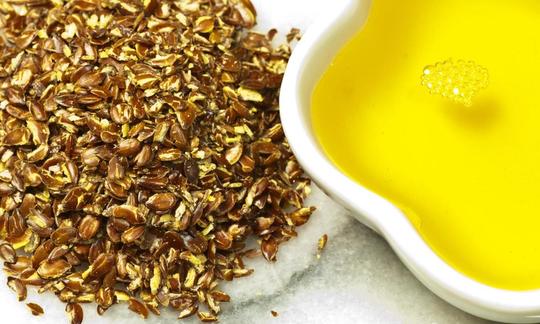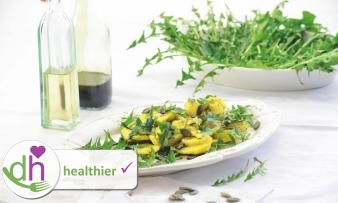Table of contents
Cold-pressed linseed oil ( linseed oil, flax oil ) is obtained from linseed, the ripe seeds of the common flax or flax plant ( Linum usitatissimum ).
Use in the kitchen
What does linseed oil taste like? Fresh linseed oil tastes slightly nutty to hay-like, after longer storage it takes on a bitter and scratchy taste. 10
You can use linseed oil to make salad dressings and dips . In Lusatia, Saxony and Silesia, linseed oil is traditionally used in dairy dishes such as quark with potatoes or boiled potatoes, in cucumber salad or in cream sauce. The layer of oil on the dairy dishes prevents them from turning sour quickly, which was something that was used in the summer. Linseed oil is also a component of many dishes in Upper Austrian cuisine. Suitable vegan alternatives include quark made from soy or almonds, vegan sour cream or soy yoghurt, which can be drizzled with linseed oil.
Due to the rapid oxidation of linseed oil, which reduces important nutrients, freshly ground linseed is suitable instead of linseed oil in muesli, e.g. in Erb-Müesli or Erb-Müesli plus oat flakes .
Can you fry with linseed oil? and: How hot can linseed oil get? Linseed oil is not suitable for stewing or frying. The oil consists mainly of polyunsaturated, reactive fatty acids, which change at temperatures just above 100 °C. Linseed oil can be used well in cold cooking or to enrich cooked dishes immediately before serving. 2
We generally recommend avoiding high heat and steaming gently or preferring raw food.
Recipe for vegan pear quark with linseed oil
Ingredients (4 servings): 120 g vegan soy quark or soy yoghurt, 1 pear, 1 teaspoon agave syrup (or 1 teaspoon liquid honey ), 2 teaspoons linseed oil.
Preparation: Put the soya quark or soya yoghurt in a bowl. Wash the pear, grate it coarsely and mix it into the quark. Sweeten with agave syrup or honey if necessary. Drizzle the pear quark with linseed oil.
The pear quark goes well with jacket potatoes or sweet potatoes .
Vegan recipes with linseed oil can be found under the note: " Recipes that have the most of this ingredient ".
| Not only vegans or vegetarians should read this: Vegans often eat unhealthily. Avoidable nutritional errors . |
Purchasing - Storage
Linseed oil is increasingly available as a controlled organic product as cooking oil, even in supermarket chains such as Coop, Migros, Spar, Aldi, Lidl, Rewe, Edeka, Billa or Hofer . Denner and Volg do not stock linseed oil in their permanent range. You can buy linseed oil in organic quality in health food stores, organic shops, drugstores such as Müller, Rossmann or DM, in local, traditional oil mills, online and in organic supermarkets such as Denn's Biomarkt or Alnatura .
Linseed oil spoils quickly after opening. That's why many retailers offer practical 50 ml bottles.
The availability of linseed oil varies depending on the size of the store, catchment area, etc. Our recorded food prices for the DA-CH countries can be found above under the ingredient image - and by clicking you can see their development at various suppliers.
Cold-pressed oils (laws, raw food)
In Switzerland, an oil is referred to as cold-pressed if the oilseed was not heated, the pressing temperature did not exceed 50 °C and no problematic post-treatment took place.
According to the Federal Department of Home Affairs ( FDHA ), an edible oil is considered cold-pressed (or may be described with synonyms such as (extra) virgin, unrefined, cold-pressed or natural) if it has been obtained by pressing or centrifuging from previously unheated raw materials, the temperature during pressing did not exceed 50 °C and it has not been subjected to refining, i.e. no neutralisation, no treatment with adsorbents, bleaching earth or steaming .
An oil may be described as “gently steamed” if the refining process was limited to steaming and the temperature did not exceed 130 °C . 24
In the EU and the USA, there does not appear to be a generally applicable temperature limit set by law for cold-pressed oils. For example, the guidelines for edible fats and oils of the Federal Ministry of Food and Agriculture (D) are similar to the EDI regulation, but they do not specify a permissible maximum temperature for general cold pressing - since they only apply to products whose labelling and composition are not conclusively set by law (i.e. not for olive oil, cocoa butter, milk fats, spreadable fats). 23
On the other hand, both the EU directives and the amendment to the EDI regulation on foods of plant origin, mushrooms and table salt (and its amendment) provide for a special rule for the labelling of olive oils . 20,21
These are selective marketing rules in which the term raw food is not defined. "Raw food" and "raw" are therefore not state-protected terms (as is the case with the term "organic"), which leaves a lot of room for interpretation. Although it is agreed that with purely mechanical cold pressing, the pressing temperatures generally do not exceed 40 °C, one should not naively assume that cooking oils are raw food quality. There is a suspicion that the measuring method used does not indicate the temperature in the press cylinder (where the heat is highest), but only the outlet temperature in the oil hose. With water-cooled olive oil presses (so-called "water-cooled 37°" oil presses), one probably cannot even say with certainty what the exact temperature is inside the press cylinder, because the entire press cylinder is surrounded by cooling sleeves.
In addition, the pressing pressure and speed as well as the moisture content of the oilseed affect the pressing temperature. If, for example, the moisture content is too low, the temperature rises during pressing and it is difficult to stay even below the maximum limit of 50 °C. 15
Storage tips
Linseed oil is very sensitive to light. It oxidizes after a short time and the oil begins to taste bitter and later rancid. The causes of this are atmospheric oxygen, light and moisture. Linseed oil should therefore be stored in a cool, dark place - especially after opening.
After opening, it is advisable to store linseed oil in a dark, airtight container in the refrigerator. It should be used up within four to eight weeks. It is therefore advisable to buy linseed oil in small bottles. 4.10
Our tip: If you don't need linseed oil for a few days, you can freeze it and thaw it in the fridge when needed. The melting point of linseed oil or flax oil is -16 to -20 degrees Celsius. Since oil does not expand when it freezes, the glass does not shatter. If you store linseed oil in a solid state, the aging process is slowed down dramatically.
Ingredients - Nutritional values - Calories
The energy content of linseed oil is 884 kcal/100g. This corresponds to about 120 kcal per 1 tablespoon. It consists almost exclusively of fat. 8
Linseed oil has a striking fatty acid pattern: in addition to 9% saturated fatty acids, it contains almost 90% unsaturated fatty acids. 53% are polyunsaturated omega-3 fatty acids (alpha-linolenic acid, ALA) . Omega-6 fatty acids (linoleic acid, LA) make up 14%. Linseed oil is considered the best food source of alpha-linolenic acid. The nutritionally very favorable ratio of LA:ALA in linseed oil is 1:4. One tablespoon provides 7.3 g of omega-3 fatty acids, which covers the daily requirement several times over. 8
Comparison with other oils: rapeseed oil (LA:ALA 2:1), camelina oil (depending on the literature source 2 or 3:1), hemp oil (LA:ALA 4:1) or walnut oil (LA:ALA 5:1). Due to their extremely high content of linoleic acid,sunflower oil, peanut oil, grape seed oil, safflower oil or corn germ oil should be avoided, as should palm oil or coconut oil, which are rich in saturated fatty acids . 8
There is only 9.3 µg of vitamin K per 100g in linseed oil (12% of the daily requirement), while walnut oil has slightly more at 15 µg per 100g. Rapeseed oil has many times more at 71 µg per 100g.
Flaxseed oil contains 0.47 mg/100g of vitamin E, similar to walnut oil (0.40 mg/100g). Sesame oil has slightly more at 1.4 mg/100g, and hemp oil has even higher levels of the vitamin at 41 mg/100g.
In order to achieve a favorable ratio of omega-6 fatty acids to omega-3 fatty acids in your diet, it is better to use seeds and nuts in the long term instead of oils and fats. Seeds (e.g. linseed, chia seeds, hemp seeds ) and nuts (e.g. walnuts ) can easily cover your needs.
The complete ingredients of linseed oil, the coverage of the daily requirement and comparison values with other ingredients can be found in our nutrient tables. In the article Nutrients explained you will get a detailed insight into the topic.
Effects on health
Is linseed oil healthy? Since oil is an unnatural concentrate, similar to sugar, we are of the opinion that no oil is actually healthy. We therefore believe it is wrong to call linseed oil a superfood. The most natural and healthiest effect comes from linseed or other whole foods such as nuts, seeds, olives or avocados (more information on this can be found under rapeseed oil ). Some prominent doctors in the USA, especially heart specialists, are actively promoting a diet without oil. Oils and fats should generally be consumed in moderation.
Which is the healthiest oil? If oil is used, then it basically depends on the amount used, the purpose and the fatty acid profile. Natural and gently pressed linseed oil has better values than many other oils. The omega-3 fatty acids contained in linseed oil are part of all cell membranes and ensure the elasticity of cells and vessels. They are found in high concentrations in the brain, nerve cells and the retina of the eye. From the plant-based alpha-linolenic acid (health-promoting omega-3 fatty acid), the body can produce the biologically active substances eicosapentaenoic acid (EPA) and docosahexaenoic acid (DHA), and from the linoleic acid (omega-6 fatty acid) arachidonic acid (arachidonic acid, AA). These starting substances are used to form hormone-like eicosanoids. 12
Can linseed oil lower cholesterol? The messenger substances formed from the fatty acids have a positive effect on the flow properties of the blood as well as cholesterol and triglyceride levels. Long-chain omega-3 fatty acids are effective in preventing cardiovascular diseases as well as rheumatism or chronic polyarthritis, chronic inflammatory bowel diseases and neurodermatitis. In nutritional medicine, however, the intake of fish oils to prevent coronary heart disease (CHD) is controversial. 11,12
Is linseed oil anti-inflammatory? While eicosanoids from EPA/DHA have antithrombotic, anti-inflammatory, bronchodilator and vasodilator effects, eicosanoids from arachidonic acid have the opposite effects. 11,13
The formation of EPA/DHA and arachidonic acid is in competition with each other because the same enzymes are responsible for this. Therefore, both the ratio of omega-6 to omega-3 fatty acids and the amount actually consumed through food are crucial. The health-promoting ratio of a maximum of 5:1 (omega-6 to omega-3) is considered desirable. A typical western diet is on average around 8 to 15:1. 7,11,13
The conversion rate of alpha-linolenic acid to EPA and DHA varies between 0.3 and 8% in men and between 9 and 21% in women. A high consumption of linoleic acid reduces the conversion rate significantly. Therefore, you should consume fewer foods rich in linoleic acid. These include grape seed oil (58-78%), safflower oil (55-81%),sunflower oil, peanut oil, etc. Animal fats, meat, eggs, cheese, etc. are even worse because they directly contain high levels of inflammation-promoting arachidonic acid (AA).
Some nutritional doctors recommend taking in EPA and DHA through food. 13,14 However, vegans generally show sufficient conversion of ALA into EPA and DHA when their intake of omega-6 fatty acids is low. 14 Data from the EPIC study ( European Prospective Investigation into Cancer and Nutrition ) suggest that the body probably produces more EPA and DHA from ALA when the intake of these higher homologues through food is scarce. 7 Scientists were able to show that the supply of EPA and DPA (precursor of DHA) was significantly improved by the administration of linseed oil.
Although the DHA level in the blood decreased, the inflammatory parameters were proven to decrease when two tablespoons of linseed oil were taken daily. 11 Of course, it would have been better to use linseed, but then it would not have been a study for the oil industry and therefore not financially possible. There is scientific evidence that DHA enrichment is possible through the sole intake of plant-based ALA when other polyunsaturated fatty acids, particularly omega-6 fatty acids, are low in the diet. 7
Secondary plant substances
Many of the health effects of linseed oil can be attributed to the secondary plant substances it contains. Our article on secondary plant substances provides an overview of the classification of substance groups, their occurrence in foods and possible effects on humans. Linseed oil contains the following secondary plant substances, among others:
- Isoprenoids : triterpenes (beta-sitosterol ), tetraterpenes ( carotenoids ); lignans 8,25,27
- Polyphenols : Hydroxycinnamic acids (ferulic acid, caffeic acid) 27
However, it should be noted that the composition of secondary plant substances in linseed oil can vary depending on the variety, time of harvest and growing conditions. Therefore, quantities are only of limited use and should only be understood roughly.
Flaxseed oil has a high antioxidant activity, similar to rapeseed oil andsunflower oil . 27 The lignans it contains prevent inflammation and have a positive effect on the immune system. 25
The positive preventive effect against cancer cells (breast cancer) and diabetes is attributed not only to the lignans but also to the omega-3 fatty acids. 25
Dangers - Intolerances - Side effects
Allergies to linseed oil are rare, but can occur. 10
Can linseed oil be harmful? An excessive intake of polyunsaturated fatty acids is associated with a higher risk of the formation of lipid peroxides and can lead to LDL cholesterol oxidation (low-density lipoprotein). The Federal Institute for Risk Assessment ( BfR ) also warns of the health risks of an excessive intake of more than 700 mg DHA/EPA per day (d). If taken in excess, they can increase cholesterol levels (from 0.7 g EPA/DHA/d) and the tendency to bleed (from 1.5 g EPA/DHA/d) and impair the immune system, especially in older people. Depending on the diet, the female metabolism can produce up to 1 g of long-chain omega-3 fatty acids (EPA, DHA) from one tablespoon of linseed oil (7.3 g ALA). The average conversion rate here is 15%, but significantly lower in men. 11,13
In 2012, the EFSA ( European Food Safety Authority ) assessed the health effects of long-chain omega-3 fatty acids. The EFSA considers up to 500 mg of EPA and DHA per day to be safe, but has not set an upper limit. 250 mg is considered sufficient for the prevention of cardiovascular diseases and the maintenance of normal heart function. 11
When polyunsaturated fatty acids are oxidized, metabolic products that damage cells can be produced. For this reason, it is important to ensure that you consume sufficient antioxidants (e.g. vitamin E or vitamin C ). 11 But we can reassure you: with a natural diet with lots of fruit and vegetables, we provide the body with enough antioxidants.
Does linseed oil contain hydrogen cyanide? Linseeds contain cyanogenic glycosides, which are converted into hydrogen cyanide through enzymatic conversion. These remain in the tester during the production of linseed oil. Linseed oil is therefore largely free of cyanogenic glycosides and does not form hydrogen cyanide during digestion. 3
Can pregnant and breastfeeding women consume linseed oil? There is insufficient evidence for the safety of linseed and linseed oil during pregnancy and breastfeeding. There is evidence that linseed oil increases the risk of premature birth. Currently, the only recommended amount of linseed is to limit the amount normally consumed, which is a maximum of 1 tablespoon (15 mg) per day. 16,17
When linseed oil is heated above 100 °C, harmful substances such as acrylamide, polycyclic aromatic hydrocarbons (PAH) or N-nitroso compounds can be produced. 2
Folk medicine - natural medicine
Linseed oil is used for pharmaceutical purposes. As a remedy, linseed oil is used as a dietary supplement (e.g. in the form of capsules) for eczema, menstrual problems, atherosclerosis (arteriosclerosis) and rheumatoid arthritis. 18
Externally, compresses with linseed oil have proven to be softening and pain-relieving. The cell-regenerating effect is helpful for painful skin cracks, burns and skin damage. 10
Is linseed oil good for the skin? Cosmetic products that contain linseed oil are said to regenerate and revitalize the skin. There is no evidence that the skin absorbs the polyunsaturated fatty acids. However, there is a significant reduction in roughness during linseed oil applications. 26
Ecological footprint - Animal welfare
The ecological footprint of linseed oil depends on the cultivation of the linseed, the processing and packaging as well as the transport. Carbon Cloud calculates the CO 2 footprint at 2.74 kg CO 2 eq/kg for European linseed oil. 5
One study found an average water footprint of 9415 l/kg for refined linseed oil. In comparison: olive oil 14,431 l/kg, refinedsunflower oil 6792 kg/l and refined rapeseed oil 4301 l/kg. 6
For detailed explanations of various sustainability indicators (such as ecological footprint, CO2 footprint, water footprint), see our article: What does the ecological footprint mean?
Animal protection - species protection
Flax plants have numerous flowers, but these only have low pollen and nectar values. Therefore, flax is less interesting as a bee pasture. 22
Worldwide occurrence - cultivation
Flax is an ancient oilseed and natural fiber plant. 10,000 years ago, flax was cultivated in Egypt, Iraq and Syria. Cultivated flax is an annual crop, while the wild forms can also be biennial or perennial. The light flax ( Linum bienne Mill.) is considered the wild parent form of the cultivated flax ( Linum usitatissimum ). 1
Flax is cultivated both for its oilseed and for its fibers. There are three easily distinguishable species of Linum usitatissimum : the tall, sparsely branched, flower-poor fiber flax, which is used to produce flax or linen, and the smaller oil flax, which has more flowers and fruits and is grown for oil production and as a fodder plant. 18 The third species is used for both purposes (fibers and seeds/oil). 1
According to the FAO, global linseed oil production in 2021 was around 699,950 tonnes. The main producers were China (225,800 tonnes), Belgium (121,600 tonnes) and the USA (69,900 tonnes). 19
Information on the cultivation and harvesting of linseeds from which linseed oil is produced can be found here .
Industrial production
Linseed oil is obtained by cold pressing ripe, crushed linseed. This is done using a screw press. The linseed is pressed through a press cylinder with little pressure. During gentle cold pressing, the temperatures are a maximum of 40 °C. 10
When linseed oil is used for technical purposes, the linseed is pressed while still warm, the press cake is extracted using solvents and the oil is refined to remove the mucilage. The resulting oil is odorless and tasteless. 10
Further information
Linseed oil is a vegetable cooking oil that is obtained from linseed, the ripe seeds of the flax plant. In addition to the actual oil linseed ( Linum usitatissimum = "most commonly used"), other types of linseed from the genus Linum are also used for oil production.
Linseed oil should not be confused with camelina oil. This is obtained from the seeds of camelina (syn. camelina sativa L.) and is also rich in alpha-linolenic acid, containing 33-39%. 9
Alternative names
Alternative names for linseed oil are linseed oil and flax oil.
Common names in the English language are flaxseed oil, linseed oil, crude linseed oil or flax seed oil.
Keywords for use
Linseed oil is used in the kitchen and in the manufacture of cosmetics. Technical uses are biofuel, binding agent for wood and window putty, production of linoleum, decorative coatings (moonlighting, wrought iron, varnish firing, patination, burnishing), corrosion protection, balm (seafaring), wood protection, binding agent for oil paints, coatings (wood primer, linseed oil paint, linseed oil varnish), violin making, painting, semi-oil, stand oil, impregnation, primer, glaze.
The press residues are used as animal feed and flax fibers are used to produce textiles (linen fabric).
Bibliography - 26 Sources (Link to the evidence)
| 1. | Xie D, Dai Z et al. Genomic variations and association study of agronomic traits in flax. BMC Genomics. 2018;19:512. |
| 2. | Unabhängige Gesundheitsberatung. Fette und Öle: Unbeschwerter Genuss in der Vollwertküche. |
| 3. | Cunnane SC, Ganguli S et al. High α-linolenic acid flaxseed (Linum usitatissimum):some nutritional properties in humans. British Journal of Nutrition. 1993;69(2):443-453. |
| 5. | Carbon Cloud. Linseed oil, Europe. |
| 6. | Mekonnen MM, Hoekstra AY. The green, blue and grey water footprint of crops and derived crop products. Hydrol Earth Syst Sci. 2011;15(5):1577–1600. |
| 7. | Unabhängige Gesundheitsberatung. Omega-3-Fettsäuen: Leinöl statt Fischöl? |
| 8. | USDA (United States Department of Agriculture): Nährstofftabellen. |
| 9. | Krist S. Leindotteröl. In: Krist S. Lexikon der pflanzlichen Fette und Öle. Wien: Springer; 2013. |
| 10. | Krist S. Leinsamenöl. In: Krist S. Lexikon der pflanzlichen Fette und Öle. Wien: Springer; 2013. |
| 11. | Becker U, Mehr Omega-3-Fettsäuren ins Essen. UGB Forum 4/15: 189-192. |
| 12. | Biesalski HK, Grimm P, Nowitzki-Grimm S. Taschenatlas Ernährung. 6. Auflage. Stuttgart; 2015. Georg Thieme Verlag. |
| 13. | Leitzmann C, Müller C et al. Ernährung in Prävention und Therapie. 3. Auflage. Stuttgart; 2009. Hippokrates Verlag. |
| 14. | Heinrich K. Ernährungsmedizin und Diätetik. 12. Auflage. München; 2014. Elsevier GmbH Urban & Fischer. |
| 15. | Schaufler D. Oilseed Fact Sheet: Oilseed Presses.Dept. of Agricultural and Biological Engineering, Penn State College of Agricultural Sciences. |
| 16. | Apotheken-Umschau. Heilpflanzen-Lexikon. Leinsamen. |
| 17. | Alberta Health Services, Nutrition Services. Nutrition Guideline Pregnangy. 2024. |
| 18. | Bown, D. Kräuter. Die grosse Enzyklopädie. Anbau und Verwendung. 2. Auflage. München; 2015. Dorling Kindersly. |
| 19. | FAOSTAT Food and Agriculture Organization of the United Nations. Oil of Linseed (Production Quantity, 2021). |
| 20. | Amtsblatt der Europäischen Union. Delegierte Verordnung (EU) 2022/2104 der Kommission vom 29. Juli 2022 zur Ergänzung der Verordnung (EU) Nr. 1308/2013. |
| 21. | EDI Eidgenössisches Departement des Innern. Verordnung des EDI über Lebensmittel pflanzlicher Herkunft, Pilze und Speisesalz (VLpH). Änderung vom 8. Dezember 2023. Inkrafttreten: 1. Februar 2024. |
| 22. | Hortipendium. Bienenweiden. |
| 23. | Bundesministerium für Ernährung und Landwirtschaft. Leitsätze für Speisefette und Speiseöle. Neufassung vom 02.07.2020 (BAnz AT 18.08.2020 B3, GMBl 2020 S. 530). |
| 24. | Eidgenössische Departement des Innern (EDI): Verordnung des EDI über Speiseöl, Speisefett und daraus hergestellte Erzeugnisse vom 23. November 2005 (Stand am 1. April 2008), Art. 3a und 3b. |
| 25. | Tripathi V, Abidia AB, Markerb S, Bilalc S. Linseed and linseed oil: health benefits - a review. International Journal of Pharmacy and Biological Sciences. 2013;3(3):434-442. |
| 26. | Neukam K, De Spirt S et al. Supplementation of flaxseed oil diminishes skin sensitivity and improves skin barrier function and condition. Skin Pharmacol Physiol. 2011;24(2):67–74. |
| 27. | Sumara A, Stachniuk A et al. Identification of sunflower, rapeseed, flaxseed and sesame seed oil metabolomic markers as a potential tool for oil authentication and detecting adulterations. PLOS ONE. 2023;18(4):e0284599. |











Comments